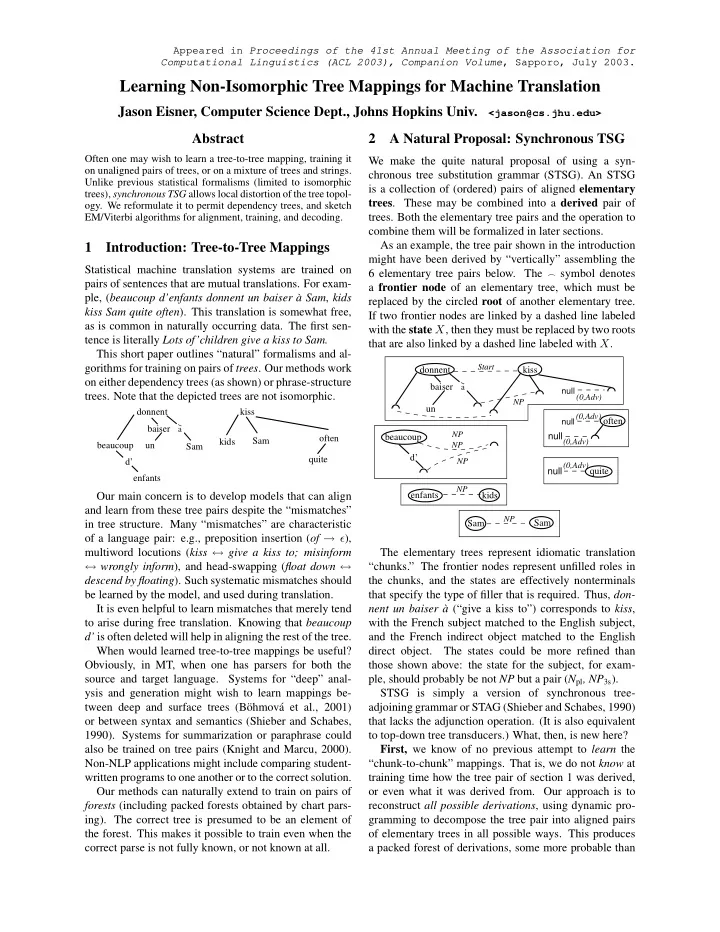

Appeared in Proceedings of the 41st Annual Meeting of the Association for Computational Linguistics (ACL 2003), Companion Volume , Sapporo, July 2003. Learning Non-Isomorphic Tree Mappings for Machine Translation Jason Eisner, Computer Science Dept., Johns Hopkins Univ. <jason@cs.jhu.edu> Abstract 2 A Natural Proposal: Synchronous TSG Often one may wish to learn a tree-to-tree mapping, training it We make the quite natural proposal of using a syn- on unaligned pairs of trees, or on a mixture of trees and strings. chronous tree substitution grammar (STSG). An STSG Unlike previous statistical formalisms (limited to isomorphic is a collection of (ordered) pairs of aligned elementary trees), synchronous TSG allows local distortion of the tree topol- trees . These may be combined into a derived pair of ogy. We reformulate it to permit dependency trees, and sketch trees. Both the elementary tree pairs and the operation to EM/Viterbi algorithms for alignment, training, and decoding. combine them will be formalized in later sections. As an example, the tree pair shown in the introduction 1 Introduction: Tree-to-Tree Mappings might have been derived by “vertically” assembling the Statistical machine translation systems are trained on 6 elementary tree pairs below. The ⌢ symbol denotes pairs of sentences that are mutual translations. For exam- a frontier node of an elementary tree, which must be ple, ( beaucoup d’enfants donnent un baiser ` a Sam , kids replaced by the circled root of another elementary tree. kiss Sam quite often ). This translation is somewhat free, If two frontier nodes are linked by a dashed line labeled as is common in naturally occurring data. The first sen- with the state X , then they must be replaced by two roots tence is literally Lots of’children give a kiss to Sam. that are also linked by a dashed line labeled with X . This short paper outlines “natural” formalisms and al- gorithms for training on pairs of trees . Our methods work Start donnent kiss on either dependency trees (as shown) or phrase-structure baiser a null (0,Adv) trees. Note that the depicted trees are not isomorphic. NP un donnent kiss (0,Adv) null often baiser a null NP beaucoup often Sam kids (0,Adv) beaucoup un NP Sam d’ quite d’ NP (0,Adv) null quite enfants NP Our main concern is to develop models that can align enfants kids and learn from these tree pairs despite the “mismatches” NP in tree structure. Many “mismatches” are characteristic Sam Sam of a language pair: e.g., preposition insertion ( of → ǫ ), multiword locutions ( kiss ↔ give a kiss to; misinform The elementary trees represent idiomatic translation ↔ wrongly inform ), and head-swapping ( float down ↔ “chunks.” The frontier nodes represent unfilled roles in descend by floating ). Such systematic mismatches should the chunks, and the states are effectively nonterminals be learned by the model, and used during translation. that specify the type of filler that is required. Thus, don- It is even helpful to learn mismatches that merely tend nent un baiser ` a (“give a kiss to”) corresponds to kiss , to arise during free translation. Knowing that beaucoup with the French subject matched to the English subject, d’ is often deleted will help in aligning the rest of the tree. and the French indirect object matched to the English When would learned tree-to-tree mappings be useful? direct object. The states could be more refined than Obviously, in MT, when one has parsers for both the those shown above: the state for the subject, for exam- source and target language. Systems for “deep” anal- ple, should probably be not NP but a pair ( N pl , NP 3s ). ysis and generation might wish to learn mappings be- STSG is simply a version of synchronous tree- tween deep and surface trees (B¨ ohmov´ a et al., 2001) adjoining grammar or STAG (Shieber and Schabes, 1990) or between syntax and semantics (Shieber and Schabes, that lacks the adjunction operation. (It is also equivalent 1990). Systems for summarization or paraphrase could to top-down tree transducers.) What, then, is new here? also be trained on tree pairs (Knight and Marcu, 2000). First, we know of no previous attempt to learn the Non-NLP applications might include comparing student- “chunk-to-chunk” mappings. That is, we do not know at written programs to one another or to the correct solution. training time how the tree pair of section 1 was derived, Our methods can naturally extend to train on pairs of or even what it was derived from. Our approach is to forests (including packed forests obtained by chart pars- reconstruct all possible derivations , using dynamic pro- ing). The correct tree is presumed to be an element of gramming to decompose the tree pair into aligned pairs the forest. This makes it possible to train even when the of elementary trees in all possible ways. This produces correct parse is not fully known, or not known at all. a packed forest of derivations, some more probable than
Recommend
More recommend